-
McWay Falls: Beauty & History in Big Sur
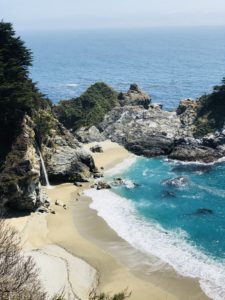 Have you ever imagined living in a home overlooking a gorgeous ocean cove, with a redwood forest behind you? What if you could look out your bedroom window and see an 80-foot waterfall cascading down a granite cliff onto a beautiful beach? One lucky couple, Congressman Lathrop Brown and his wife, Helene, were privy to this view for many years. Lathrop Brown served as best man at his friend Franklin Delano Roosevelt’s wedding. His wife, Helene, was a wealthy heiress. In 1924 they visited Big Sur and became smitten with the area. They purchased Saddle Rock Ranch from pioneer homesteader Christopher McWay. They built a crude redwood cabin at the top of the cliffs facing McWay Falls. In 1940, they replaced this with a fancy two-story mansion. They named it “Waterfall House”.Waterfall House featured fine furnishings, paintings, and an entryway inlaid with brass fish, a gold octopus, and a rose compass. Their ranch foreman, Hans Ewoldsen, built a Pelton wheel from hand-split redwood and installed it on McWay Creek in 1932. This wheel supplied a 32-volt generator with the first source of electricity in Big Sur. It powered three homes, a blacksmith shop, and a funicular railway. What is a funicular railway, you ask? It is a railway on an incline. The Browns used a modified mining car operated by cable to travel up and down the steep Big Sur slope.The Browns left Big Sur for Florida in 1956, and after her husband died, Helene donated the property to the state for a museum and park. For various reasons, the home was demolished in 1965. Helene had stipulated that the park be named for her friend, Julia Pfeiffer Burns, “a true pioneer”. Julia, with her husband, raised cattle at Saddle Rock Ranch before the Browns’ arrival. At the overlook of McWay Falls, you can still see vestiges of the Brown home, landscaping, and railway.Photographers love this area, and it is easy to see why. The sand is often purple from the erosion of manganese garnet which is carried down the creek to the beach. This is generally more apparent after winter storms. Light plays on the colored sand and waves crash through sea sculptured arches and rock formations, creating a beautiful vista. The hills are covered with wild yarrow and pink morning glories. The area is surrounded by redwood, tan oak, madrone, and chaparral. Tall, stately eucalyptus trees line the trail and fill the air with their scent.
Have you ever imagined living in a home overlooking a gorgeous ocean cove, with a redwood forest behind you? What if you could look out your bedroom window and see an 80-foot waterfall cascading down a granite cliff onto a beautiful beach? One lucky couple, Congressman Lathrop Brown and his wife, Helene, were privy to this view for many years. Lathrop Brown served as best man at his friend Franklin Delano Roosevelt’s wedding. His wife, Helene, was a wealthy heiress. In 1924 they visited Big Sur and became smitten with the area. They purchased Saddle Rock Ranch from pioneer homesteader Christopher McWay. They built a crude redwood cabin at the top of the cliffs facing McWay Falls. In 1940, they replaced this with a fancy two-story mansion. They named it “Waterfall House”.Waterfall House featured fine furnishings, paintings, and an entryway inlaid with brass fish, a gold octopus, and a rose compass. Their ranch foreman, Hans Ewoldsen, built a Pelton wheel from hand-split redwood and installed it on McWay Creek in 1932. This wheel supplied a 32-volt generator with the first source of electricity in Big Sur. It powered three homes, a blacksmith shop, and a funicular railway. What is a funicular railway, you ask? It is a railway on an incline. The Browns used a modified mining car operated by cable to travel up and down the steep Big Sur slope.The Browns left Big Sur for Florida in 1956, and after her husband died, Helene donated the property to the state for a museum and park. For various reasons, the home was demolished in 1965. Helene had stipulated that the park be named for her friend, Julia Pfeiffer Burns, “a true pioneer”. Julia, with her husband, raised cattle at Saddle Rock Ranch before the Browns’ arrival. At the overlook of McWay Falls, you can still see vestiges of the Brown home, landscaping, and railway.Photographers love this area, and it is easy to see why. The sand is often purple from the erosion of manganese garnet which is carried down the creek to the beach. This is generally more apparent after winter storms. Light plays on the colored sand and waves crash through sea sculptured arches and rock formations, creating a beautiful vista. The hills are covered with wild yarrow and pink morning glories. The area is surrounded by redwood, tan oak, madrone, and chaparral. Tall, stately eucalyptus trees line the trail and fill the air with their scent.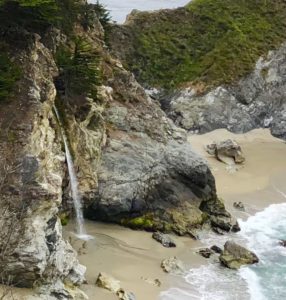
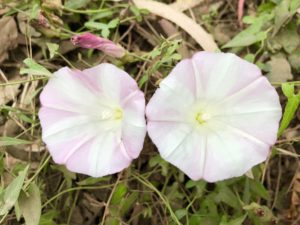
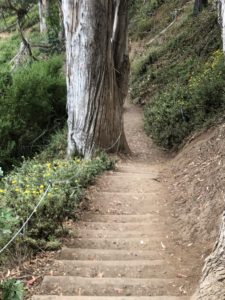 The waterfall flows year round from McWay Creek and is one of only two entering the ocean in California. Visitors are not allowed access to the beach to protect the marine resources and the pristine beauty of the cove. Per Julia Pfeiffer Burns State Park, ” Cliff areas beyond the fenced boundaries, including the BEACH, SADDLE ROCK and MCWAY FALLS area are completely off limits. Trespassing into these closed areas is a serious offense, resulting in a citation and arrest. The areas are extremely hazardous.” Be safe and stay on the Waterfall Trail.
The waterfall flows year round from McWay Creek and is one of only two entering the ocean in California. Visitors are not allowed access to the beach to protect the marine resources and the pristine beauty of the cove. Per Julia Pfeiffer Burns State Park, ” Cliff areas beyond the fenced boundaries, including the BEACH, SADDLE ROCK and MCWAY FALLS area are completely off limits. Trespassing into these closed areas is a serious offense, resulting in a citation and arrest. The areas are extremely hazardous.” Be safe and stay on the Waterfall Trail.

The Tunnel leading from adjacent Parking Lot to Trail You can reach McWay Falls either by 1. parking at JPBSP and walking through a short tunnel under the highway, or 2. parking alongside highway 1 and hiking on the Waterfall Trail to the viewing area. There is a 10.00 fee to park at JPBSP. It opens 30 minutes before sunrise and closes 30 minutes after sunset. There are restrooms available there. If you park along the highway, be mindful of traffic as this is a busy road. Also, if you park on the road, you will have to go down a set of several steps to reach the trail. You may also want to bring a sweater or jacket as it can get quite blustery here.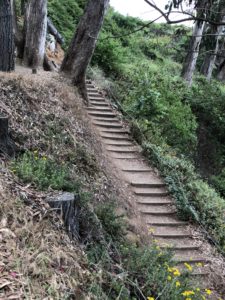
Stairs from Hwy 1 to Trail 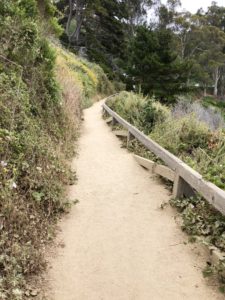
The Trail is Easy to Navigate For more information see parks.ca.gov Thank you for visiting my blog! Wishing you peace, love, happiness, and beautiful vistas!
-
Common Chicken Sayings
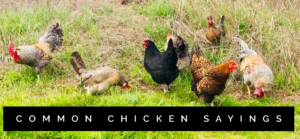
It is amazing to me that so many everyday sayings refer to chickens. The following is a list of phrases referencing chickens.
Be chicken- to be afraid
Nest egg – to save a little money each week
Scratching out a living – to earn enough to get by on
Don’t count your chickens before they hatch – don’t plan on something before it actually happens.
Don’t put all your eggs in one basket – don’t plan on an outcome before it actually happens.
Chicken feed – small amount of money
Feather your nest – saving for the future
Hen house – large number of females living in the same house
Mother hen – very protective
Madder than a wet hen – very angry
Fussing like an old hen – angry
Scarce as hen’s teeth – extremely hard to find
Chick – a woman
Hen-pecked – nagged
The rooster may crow but the hen delivers the eggs
Rooster games – willing to fight instead of trying to work out a problem
Flew the coop – gone
Up with the chickens – waking early with the sunrise
Walking on eggshells- treading softly where certain people are concerned; trying not to upset someone
Like a chicken with it’s head cut off – running around with no direction
Shake a tail feather – get moving
Strutting’ your stuff – Showing off
Bird brain – senseless
Dumb cluck – senseless
Ruffle your feathers – something annoys you
Chicken hearted – Not brave
No spring chicken – An old person
Hatch an idea – put a plan into motion
Egg on your face – caught in an untruth
Rule the Roost – to be the boss
Pecking order – hierarchy, your rank
Play Chicken – a stand off, who will give first
Brood over it – to worry over a problem
Chicken scratch – poor handwriting
Bad egg – less than honest person; poor moral standards
You have to break eggs to make an omelet – sometimes you need to make a mess to get something done
It’s not what it’s cracked up to be – disillusionment
I hope you enjoyed this! Happy Tuesday!
-
A Single Ember: Soberanes & California Wildfires

Living in California involves a delicate dance between nature and man. The high drought of summer contrasts with the lush rainy season of winter. One can become complacent, expect things to go on just as perfectly as ever in this coastal paradise, never realizing that one small spark can lead to such horrible consequences. California wildfires are becoming bigger and more devastating, and there cannot be too much education regarding prevention, in my opinion. There is a new ad campaign out with the message “A single ember can travel over a mile”, and I seriously hope people think about this.
The year I moved to my farm there was a fire in north Corral de Tierra, supposedly caused by a trailer dragging chains along the highway, which created a series of sparks jumping alongside the dead grass ditches and transmogrifying into a pitched wildfire. There was also another fire to the south in Tassajara set by a purportedly suicidal man who set himself on fire in his car, initiating a wildfire which burned uncontrollably for weeks. Last year I journaled my experience during the devastating 2016 Soberanes fire.
—I see a faint flicker of difference in the lighting the minute I step outside. The normally blue sky is now somewhat pink as if someone is holding a gargantuan piece of rose colored fabric between the sun and earth. I do not see flames but I soon learn their inauspicious cause. It is coming from Soberanes, an area located south of Monterey and Carmel, with trails snaking through steep hills overlooking the Pacific Ocean along the Big Sur Coastline. Local firefighters as well as those from further north in San Francisco are now battling the fire in this remote and heavily forested area.
Each day I wake to find a smattering of white flakes like a delicate sprinkling of fine snow powdering the tawny hillside. It is ash confetti from the wildfire being blown over in a sobering morning kiss. I see photos of firefighters on the news contrasted with smoke and flame. Their faces are cavernous and hollow. Their eyes are worn, haunted. They look tired of the fighting the flames. They just look done in. By day 10, the fire is approaching Carmel Valley. They say five fire lines have been cut to prevent the fire from reaching the village. That is what they say.
It has now been over two weeks and the fire is moving south. They say it is 50% contained. The firefighters say it was caused by an illegal campfire set at the junction where two meandering creeks met to form a waterfall in the depths of Garapatta forest. At least 57 homes and buildings have been burned up, and a bulldozer operator working to clear brush was killed when his bulldozer topped over on the steep terrain, crushing him beneath. The horrible stench of smoke I have awoken to the past several days is waning, although they say on the news our poor air quality is approaching that of Delhi, India.
Who set the campfire? Stories have been circulating. One involves a group of homeless people from Santa Cruz who were asked to leave by forest rangers but returned later to move even further into the forest. Was it a campfire of revenge? Another story involves the possibility of a couple out for a hike who became enticed by the beauty of the streams and waterfall and stopped for a romantic tryst, hastily lit a campfire, then abandoned it. Stories are stories. Whatever the reason, the effect of their actions is entirely devastating.—
The Soberanes Fire was eventually quelled after three months, and was deemed the most expensive wildfire to fight in United States history. Sadly, most wildfires are caused by PEOPLE. According to CalFire and the Forest Service, the following can cause wildfires: burning debris, smoking, unattended campfires, kids playing with matches, sparks from trains, outdoor equipment such as weed whackers, and the heat from catalytic converters in autos. If you are visiting California, please check with the local authorities before having a campfire. There are often strict penalties for unapproved fires here, and as you can see, for good reason. Peace out!
-
Big Little Lies: Blue Blues Cafe

Big Little Lies Season 2 is in full swing, and since I was in the vicinity of the area Blue Blues Cafe scenes were filmed, I thought I would snap some pics. For those of you not familar with the famous HBO series, Blue Blues is the harborside coffee shop where Madeline, Celeste, and Jane meet to dish and commiserate over coffee and lunch.

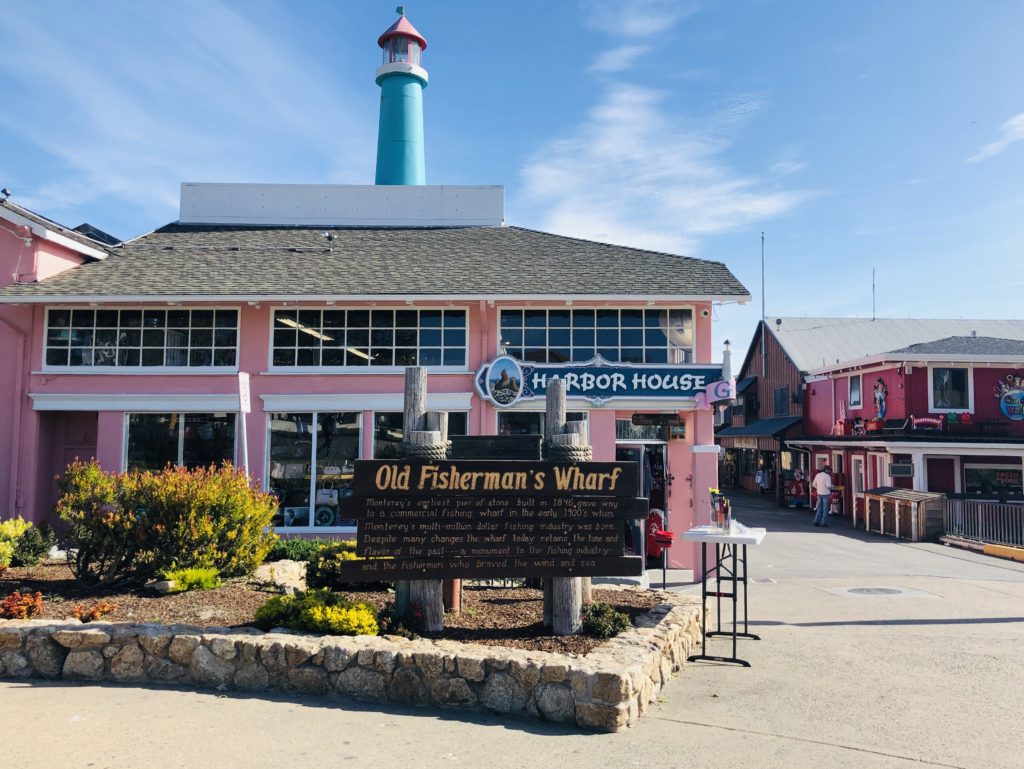
Blue Blues Cafe is actually a restaurant on Old Fisherman’s Wharf called Paluca Trattoria. Fisherman’s Wharf is generally a bustling, touristy area, filled with souvenir shops, eateries, and is the starting point for whale watching tours. It is hardly the place I would picture these three ladies meeting. However, when I turned the corner and discovered this more secluded and quiet place over the water, it definitely exuded the charm and ambiance seen in the film.
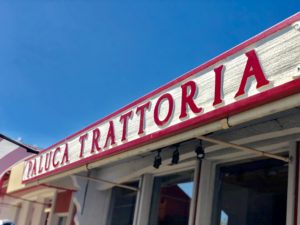
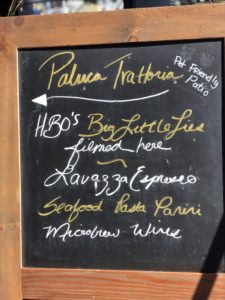
It looks exactly like it did in Big Little Lies. Amazing!
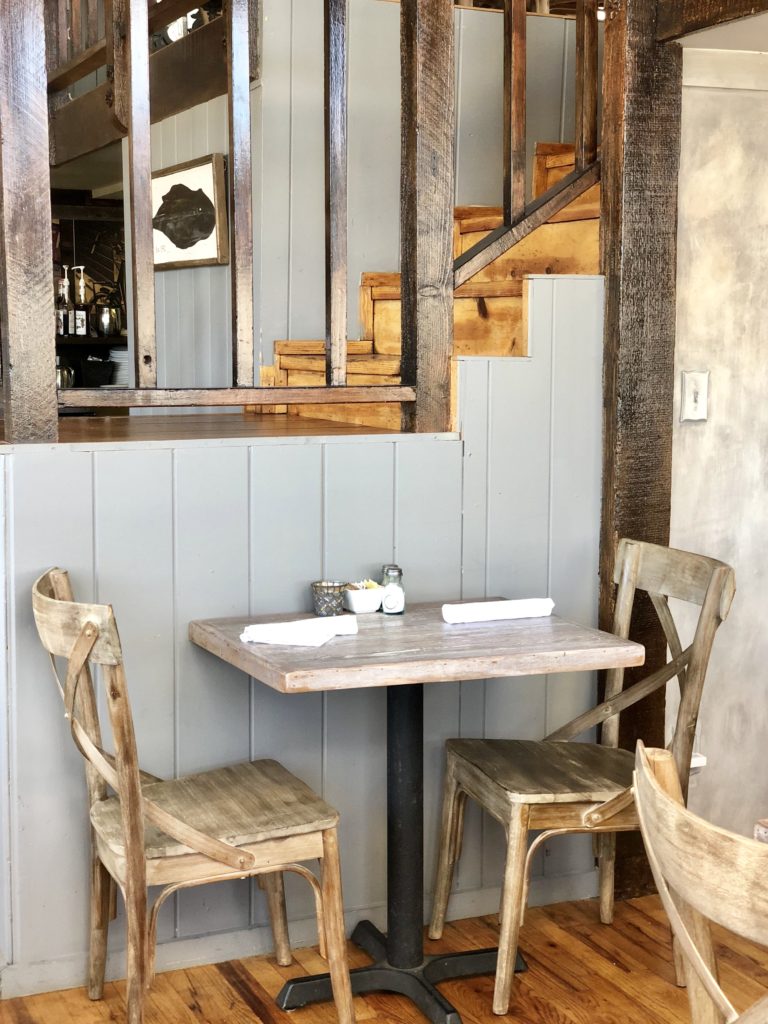
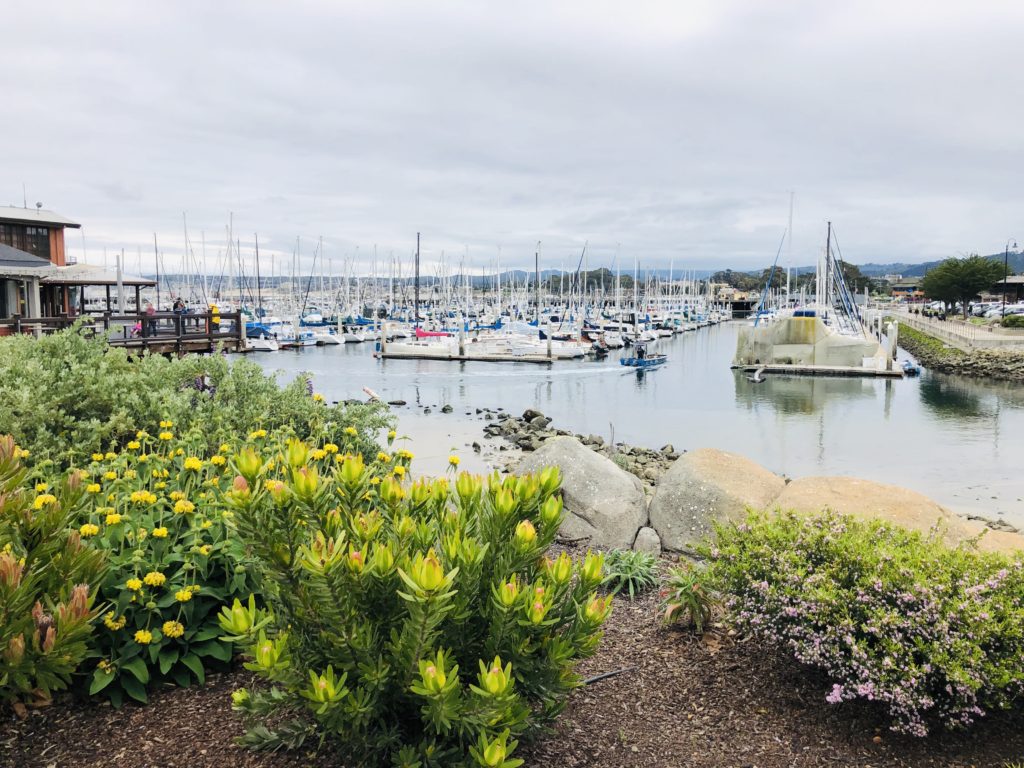
The view of the harbor from the restaurant is beautiful, with boats bobbing gently on the blue waves, seagulls gliding by, and the resident sea lions and otters making their own cameo appearances from time to time. It looks just as it must have looked to Celeste, Madeline & Jane as they sat in the sunshine with their espresso and schmoozed with the cute coffee guy, Tom.
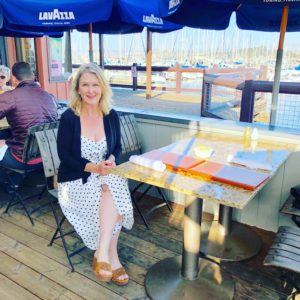
If you come to Monterey, you should take some time to visit this cozy place. Pick a chair overlooking the harbor, order an espresso, and contemplate the vagaries of life. I’m sure Tom, Celeste, Madeline, and Jane would approve.
Thank you for visiting my blog. Wishing you peace, love, happiness, and beautiful vistas!
-
Rare Chickens: Beautiful & Healthy Eggs
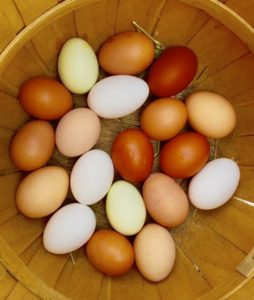
When you raise your own chickens, you gain peace of mind knowing exactly where your eggs came from. Organic and free-range eggs contain higher levels of Omega-3 fatty acids, beta carotene, Vitamin E, and Vitamin A. They are also lower in saturated fat and cholesterol than conventional, store-bought eggs.
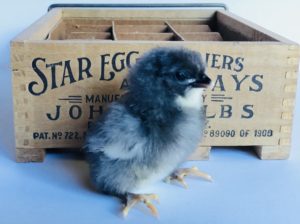
When I first moved to my farm, raising my own chickens was a priority. I could not wait for my first eggs to arrive. I started out with your average, run-of-the-mill chickens such as Leghorns and Australorps from the local farm supply store, but soon I became fascinated by the more rare, heritage breeds, especially those that laid eggs in novel colors. I now focus on raising the following breeds:
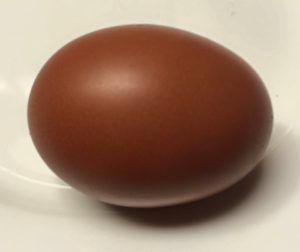
- French Marans. French Marans lay deep chocolate brown colored eggs, that when cracked open reveal a bright orange, yolk, bursting with vitamins, protein, and fats from its healthy lifestyle. Marans have the reputation for laying the best-tasting chicken egg in the world. (Perhaps, for these reasons, the author Ian Fleming identified Marans eggs as those most preferred by James Bond.) I raise ultra-rare Birchen Marans. My Marans are extremely docile and sweet.
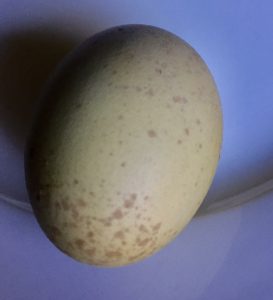
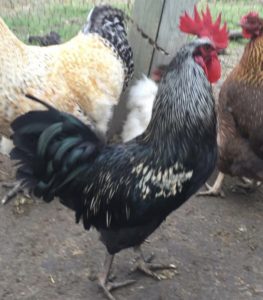
2. Swedish Isbars. Swedish Isbars are thrifty foragers that will produce 150-200 green eggs a year. The eggs vary in shade of green from a dark olive to a lighter moss green. Some eggs also have small brown speckles against a green background, and many chicken aficionados think Isbar eggs are the most beautiful of any egg. Whether speckled or pure green, the Isbar eggs are as magical and exotic as the birds themselves. I love that when hatching Isbar eggs, you literally never know what color chicks you will get! They range in color in unique variations of black, grey, and white.
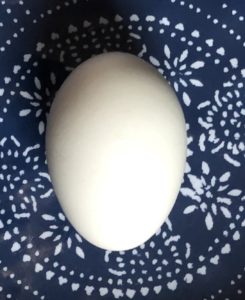
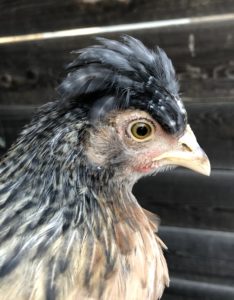
- Cream Legbars. Cream Legbars were first introduced at the London Dairy Show in 1947 and received a written standard by the Poultry Club of Great Britain in 1958. Legbars grew in popularity to fill a niche market in the British egg industry for pastel sky blue eggs produced by free-range birds. Cream Legbars are medium-sized fowl that are known for their active foraging and ability to survive in a free-range environment. The females look like they are wearing little beret hats. I think they are just adorable!
Raising chickens involves some basic dedication: ensuring they have clean water, fresh food, and a clean coop. But the rewards are amazing: fresh eggs, beautiful feathered friends, insect pest control, and last but not least—chicken manure makes great compost for your garden. I highly recommend the keeping of chickens!
- French Marans. French Marans lay deep chocolate brown colored eggs, that when cracked open reveal a bright orange, yolk, bursting with vitamins, protein, and fats from its healthy lifestyle. Marans have the reputation for laying the best-tasting chicken egg in the world. (Perhaps, for these reasons, the author Ian Fleming identified Marans eggs as those most preferred by James Bond.) I raise ultra-rare Birchen Marans. My Marans are extremely docile and sweet.
-
How to Create Vintage Farmhouse Floral Displays
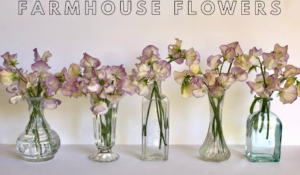
The best things in life are free: hugs, kisses, the beach, fresh clean air, a good night’s sleep, and flowers! If you are an avid gardener like me, you may often wonder how to display your cut flowers. Here are some great ideas! It is easy to create gorgeous farmhouse floral displays using these simple tips. Wondering what to do when you have dainty or fragile flowers, or just one or two flowers? I found a great solution. I went to my local thrift stores and found all these cute little vintage vases and jars. Each was no more than two or three dollars.
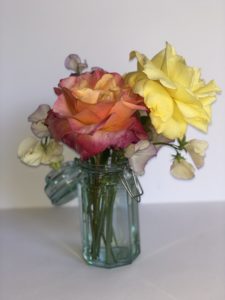
I have found that simplicity is often the best strategy in life and that also holds true in arranging flowers. I cut my “April in Paris” sweet peas and arranged in these vintage holders, along with a couple of pastel roses. Grouped together, these diminutive vases create an informal, lovely display, and their delicious sweet fragrance will fill your home! These look great together on a farmhouse table, an old trunk, or lined up on a fireplace mantle!
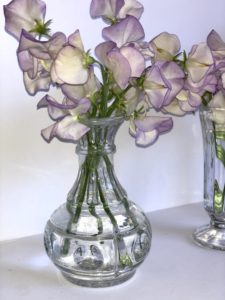
Another great idea for a cute farmhouse display. I used a vintage wooden fruit crate and filled it with Potatoe Vine, Sunflowers, and Rose of Sharon.
.
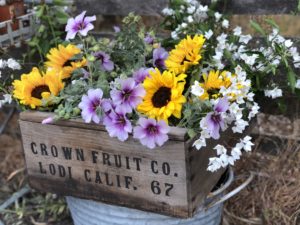
Keys to keeping cut flowers fresh: snip just the tips off the bottom of the stems after a few days. This will enable the flowers to “drink” as much water as possible. It is also a good idea to replace the water every few days. This will keep your flowers looking pretty even longer!
-
When Your Chicks Have Hatched, 7 Easy Steps

So your chicks have hatched! What next? You will need the following supplies: Large Rubbermaid Bin, at least 20”x 34”, without lid; Newspaper; Clip-on Brooder Heat Lamp OR Brinsea Ecoglow*; Chick Feeder; Chick Waterer. This is for hatches of 10-12 chicks or LESS.
1. Spread newspaper on bottom of bin. I like newspaper because it’s free and is easy to change. You should replace soiled newspaper at least every 2-3 days.
2. Firmly attach heat lamp to side of bin with lamp directly over inside of bin or place Ecoglow along the inside of the bin. Plug cord into electrical outlet. *As I mentioned in “8 Steps to Perfect Chick Hatching”, I prefer the Ecoglow because it is safer than the Lamp. As the chicks grow they will become much more active and adventurous, climbing and flying. They can potentially knock the heat lamp down. This happened to a friend of mine and she came home to find a fire in her coop. Not good! Also, the Ecoglow is much cheaper to run and will save you money in the long run, especially if you are planning multiple hatches. Another plus to the Ecoglow is that it has three adjustable heights: lowest for newborns, medium at around two weeks old, and the top height when they reach four weeks.
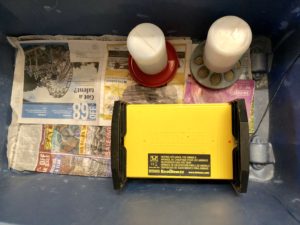
3. Fill the chick waterer and chick feeder and place near the Ecoglow. Newborn chicks need quick access to food and water. Later, you can move these further away to help maintain cleanliness. 24-36 hours after hatching, move the chicks from the incubator to the bin, ensuring they are beneath the heat lamp or Ecoglow. You may need to adjust the height of the heat lamp: if the chicks are snuggled tightly together and crying it may be too high. If they are scattered on the outskirts away from the heat lamp it may be too low. Happy chicks may peep and bustle about but will not cry. Make sure that chicks understand how to drink; you may need to dip their beaks gently into the water at first. Usually, once one or two chicks have mastered this, the others will imitate them.
4. Frequently check your chick’s bottom for “pasty butt”, a condition where poop builds up in a hard little clump on the feathers surrounding the chick’s vent and prevents further pooping. This can result in death. Gently remove the poop clump using a soft cloth and some petroleum jelly or mineral oil.
5. Keep chicks in the bin for 4-6 weeks, at least until the feathers covering their undersides have come in, before moving them to a bigger coop.
-
Life in the Country
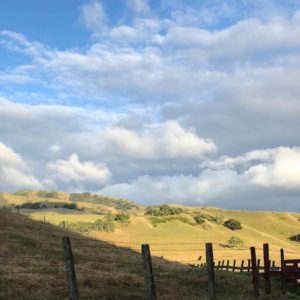
“It’s your road and yours alone. Others may walk it with you, but no one can walk it for you.” This quote compelled me to write about my life on a dirt road in the California countryside.
When you live in the country on a dirt road you will never have a clean car. You will wash it to no avail, as the thick clouds of dust created when you drive on the road will quickly cover your vehicle in a fine gray layer. The dust will waft from the road into your house each time you open a window or door, so that your house can never be kept clean either, no matter how much you dust and sweep.
When you live in the country on a dirt road, you will dread the heavy rains, because you know it will mean a dance with death as you navigate your vehicle along the long slippery stretch hoping you don’t slide into the cliff wall, or worse yet, skid over the other side that plunges seventy-five feet below.
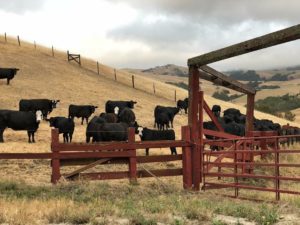
When you live in the country on a dirt road, you learn to watch for sinkholes in the road that start as big around as a man’s arm and suddenly become large enough to swallow your car. You will pass dozens of black cattle peppering the hillside and filling the silence with their gentle mooing. Sometimes one will squeeze through the fence and you will spot it trotting nonchalantly along the road until the ranch hands catch it and return it to the fenced in pasture.
When you live in the country on a dirt road, sometimes you will see a roadrunner darting quickly across or a tarantula crawling slowly along. You will learn the difference between rattlesnakes and bull snakes and learn to set the good black and white striped king snakes free when they become trapped in your garden’s protective netting. You will learn to recognize the ubiquitous poison oak and to avoid touching it lest you break out in the familiar horrible, itchy rash.
When you live in the country on a dirt road you will find that you can’t leave your chickens out past supper time or the Bobcats will get them. You will watch a team of wild pigs running fast near the creek in the quiet dusky evenings. You will hear a pack of coyotes howling just over the hill. You will lie on your back in the night and see every distant star in the galaxy and make a wish on one. You will see the Milky Way floating distantly like an ethereal plate and think about how tiny and inconspicuous you really are.
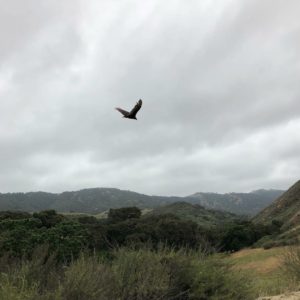
When you live in the country on a dirt road, it is almost two miles to your mailbox, but if you walk to it, you have time to notice the wildflowers: purple lupines, orange sticky monkey flowers, pink shooting stars. You will smell the fresh scent of eucalyptus after the rain. You will see blue jays, magpies and doves sitting on fence posts, quail scuttling along the road, and hawks and vultures swooping and circling rhythmically in the air. And sometimes you will see the hoof prints of deer, and then those of a mountain lion, and then both sets of prints will disappear.
When you live in the country on a dirt road, you wave at everyone you see walking by, and you smile because people are friendly and so are you. Sometimes you stop to chat with a neighbor who lives further down the road. And sometimes you see people you have hiked with in the past, and they will invite you to share a bottle of wine.
When you live in the country on a dirt road, life is good and it is simple. And sometimes, that is all you need.
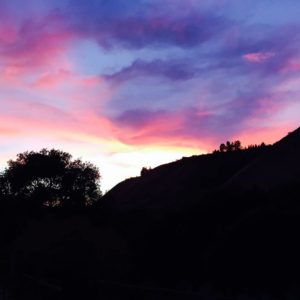
-
Eight Easy Steps To Perfect Chick Hatching

I started out hatching and raising chickens, without any experience, and so can you! Follow my 8 easy steps:
- Make sure you start with fresh, healthy, fertilized eggs.Discard any that are cracked or have any odor. Do not use any eggs older than two weeks.

- Get a good incubator. In my opinion Brinsea is the best for people starting out. I started out with the Brinsea Mini Advance and then moved up to a Brinsea Octagon Advance because it holds more eggs than the Mini and it is easier to monitor humidity levels than the Mini.
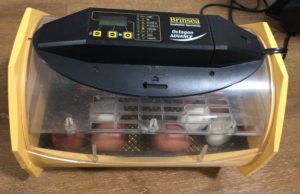
- Set the temperature between 99.4 -99.6 degrees F.
- Make sure that from day one through day twenty your humidity is consistently between 40-50%. I add water daily to my Brinsea incubator to ensure consistent humidity at this level.
- Ensure that the eggs are being rotated regularly, just as the mother hen would do herself. Brinsea ensures that this occurs do you don’t have to worry about it.
- On day 19, stop the rotation on your device (on the Octagon just remove the cradle) so that the eggs remain stable and remove any brackets holding the eggs in place
- On day 21, add enough water to get humidity levels to 65%.This will enable the chicks to peck out of their shell.
- This is the hardest but most important step. Do not take the cover off your incubator until nearly all eggs have hatched. This may take up to three days! I learned the hard way. If you take the cover off, even briefly, the change in humidity can literally shrink wrap all chicks in eggs in the process of hatching and increase their mortality rate substantially. Tempting as it may be, leave them alone! Don’t worry about getting them food and water right away; for up to 72 hours after they hatch, baby chicks are still ingesting their yolk sacs. This provides them all the nourishment they need.
Not all of your eggs may hatch, some may start to pip and then stop. There is usually a good reason they are not strong enough to survive, it is normal to not have a 100% hatch rate. After 24- 36 hours from the first chick hatch you may transfer the chicks to their next home: either the Brinsea Ecoglow Brooder or beneath a 250 Watt Red Heat Lamp. I started with the red heat lamp and switched to the Ecoglow brooder because A. it is cheaper to maintain, and B. it is much safer. I will discuss this more in “When Your Chicks have Hatched”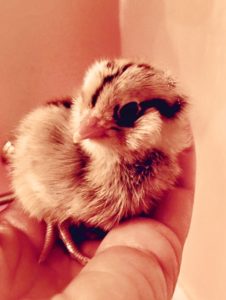
- Make sure you start with fresh, healthy, fertilized eggs.Discard any that are cracked or have any odor. Do not use any eggs older than two weeks.
-
Point Pinos Lighthouse, Pacific Grove
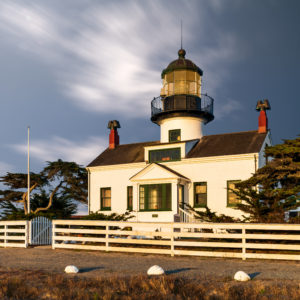
Point Pinos Lighthouse, located In Pacific Grove, is the oldest continuously operating lighthouse on the west coast of the United States. In 1855, it was the second lighthouse built in California. Alcatraz Island Lighthouse had been built 8 months previously, but in 1909 was replaced by the famous prison. Point Pinos was built atop a quaint house enabling keepers to tend the light without fearing the elements. Point Pinos Lighthouse uses a Fresnel lens manufactured in France in 1853. The beacon is still used by the Coast Guard to aid navigation and the city of Pacific Grove maintains the property. While it began as just a narrow light beam fueled by whale oil, in 1912 it used an “eclipse” that made the light blink on for 10 seconds and off for 20 seconds. Today, the light is electronic and is on for three seconds and off for one, which helps mariners identify it. Point Pinos stands 43 feet tall, approximately 90 feet above the ocean, and its lens can be seen 17 miles out to sea.
History
Point Pinos Lighthouse has had many keepers, but perhaps the most interesting was Emily Fish. Emily Fish’s sister died in childbirth, and at age 17, Emily married her dead sister’s husband, Malancthon Fish, and raised her sister’s baby daughter, Juliet. Mr. Fish, a medical doctor, died when Emily was 50 years old. Following his death, Emily applied for the position of lighthouse keeper at the Point Pinos Lighthouse in Pacific Grove, CA. This was considered highly unusual, as most women only received their positions upon the death of their lighthouse keeper husbands. Emily, however, was an anomaly. She bucked the norms and defied gender roles. She would not be foiled in her efforts, proving that no matter how old you are and what society thinks, you should always follow your dreams and aspirations.
She thrived in her position, and for over twenty years, lived and worked at the lighthouse with her menagerie of French poodles, Holstein cows, horses, and chickens. She excelled at gardening and created an oasis of grass, hedges, and trees on the lighthouse grounds. From her home in Oakland, she brought antique furniture, paintings, china, and silverware. Being a lighthouse keeper was no easy chore; rather, it was a difficult and demanding life. Emily, however, excelled at her job, and soon became known as the “Socialite Keeper” because of her flair for style and fashion and her reputation for entertaining guests at the lighthouse. During her keep, Point Pinos Lighthouse consistently received high marks for being well-kept.
While Emily is the most memorable female lighthouse keeper at Point Pinos, she was not the first. The light’s first keeper, Charles Layton, was serving on a posse in pursuit of an outlaw when he was fatally shot the first year he was appointed. His wife Charlotte, left alone with four children, replaced her husband as keeper until 1860 when she was remarried and her new husband took over the position.
If you are planning on visiting the area and would like to tour the lighthouse, please see pointpinoslighthouse for information including directions, hours, and parking. *Photo courtesy of Jay Slupesky, follow him on Instagram @jayslu